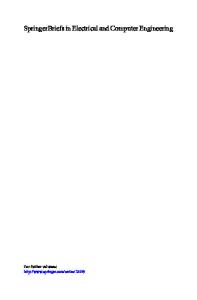Recommender Systems in E-Learning Environments
Recommender system can be defined as a platform for providing recommendations to users based on their personal likes and dislikes. These systems use a specific type of information filtering technique that attempt to recommend information items (movies, mu
- PDF / 248,867 Bytes
- 25 Pages / 439.37 x 666.142 pts Page_size
- 2 Downloads / 420 Views
Recommender Systems in E-Learning Environments
Abstract Recommender system can be defined as a platform for providing recommendations to users based on their personal likes and dislikes. These systems use a specific type of information filtering technique that attempt to recommend information items (movies, music, books, news, Web pages, learning objects, and so on.) to the user. Recommender systems strongly depend on the context or domain they operate in, and it is often not possible to take a recommendation strategy from one context and transfer it to another context or domain. Personalized recommendation can help learners to overcome the information overload problem, by recommending learning resources according to learners’ habits and level of knowledge. The first challenge for designing a recommender component for e-learning systems is to define the learners and the purpose of the specific context or domain in a proper way. This chapter provides an overview of techniques for recommender systems, folksonomy and tag-based recommendation to assist the reader in understanding the material which follows in subsequent chapters.
Recomender systems (RS) strongly depend on the context or domain they operate in, and it is often not possible to take a recommendation strategy (Drachsler et al. 2009) from one context and transfer it to another context or domain. The first challenge for designing a RS is to define the learners and the purpose of the specific context or domain in a proper way (McNee et al. 2006). Learning process includes three components: learners, teachers/instructors, and learning materials. From a teacher’s point of view, teaching is an activity to deliver information and skill to learners with some goals to be achieved. From the learners’ point of view, learning is an activity to acquire information from teacher to achieve goals set by the teacher. Learners, with their prior knowledge, acquire new information from the teacher. Here, social constructivism paradigm can help learners learn collaborative and sharing knowledge with each other. Basically, knowledge which is needed to be achieved according to the course, mainly does not influence how many Learning
© Springer International Publishing Switzerland 2017 A. Klašnja-Milićević et al., E-Learning Systems, Intelligent Systems Reference Library 112, DOI 10.1007/978-3-319-41163-7_6
51
52
6 Recommender Systems in E-Learning Environments
Objects (LOs) the learners have read, but how relevant are LOs that have retrieved and learned. A learner who has high prior knowledge according to the course is different from other learners who have low prior knowledge. In a virtual classroom, teachers provide resources such as text, multimedia and simulations, and moderate and animate discussions. Remote learners are encouraged to peruse the resources and participate in activities. However, it is very difficult and time consuming for educators to thoroughly track and assess all the activities performed by all learners on all tools. Moreover, it is hard to evaluate the stru
Data Loading...











